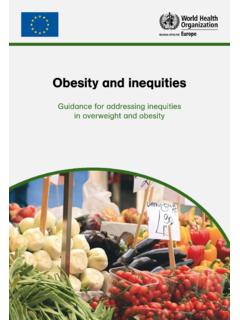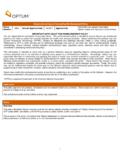Transcription of Population-based approaches to CHILDHOOD OBESITY …
1 Population-based approaches toCHILDHOOD OBESITYPREVENTIONP opulation-based approaches toCHILDHOOD OBESITYPREVENTIONWHO Library Cataloguing-in-Publication DataPopulation-based approaches to CHILDHOOD OBESITY - prevention and control. welfare. habits. health services. participation. Health 978 92 4 150478 2 (NLM classification: WD 210) World Health Organization 2012 All rights reserved. Publications of the World Health Organization are available on the WHO web site ( ) or can be purchased from WHO Press, World Health Organization, 20 Avenue Appia, 1211 Geneva 27, Switzerland (tel.: +41 22 791 3264; fax: +41 22 791 4857; e-mail: Requests for permission to reproduce or translate WHO publications whether for sale or for non-commercial distribution should be addressed to WHO Press through the WHO web site ( ).The designations employed and the presentation of the material in this publication do not imply the expression of any opinion whatsoever on the part of the World Health Organization concerning the legal status of any country, territory, city or area or of its authorities, or concerning the delimitation of its frontiers or boundaries.)
2 Dotted lines on maps represent approximate border lines for which there may not yet be full mention of specific companies or of certain manufacturers products does not imply that they are endorsed or recommended by the World Health Organization in preference to others of a similar nature that are not mentioned. Errors and omissions excepted, the names of proprietary products are distinguished by initial capital reasonable precautions have been taken by the World Health Organization to verify the information contained in this publication. However, the published material is being distributed without warranty of any kind, either expressed or implied. The responsibility for the interpretation and use of the material lies with the reader. In no event shall the World Health Organization be liable for damages arising from its use. Printed by the WHO Document Production Services, Geneva, Switzerland Design and layout: of figures 7 List of boxes 7 Abbreviations 8 Acknowledgements 9 Executive Summary 11 Introduction CHILDHOOD OBESITY Key global strategies related to OBESITY prevention WHO Forum and Technical Meeting on Population-based Prevention Strategies for CHILDHOOD OBESITY Purpose and structure of the document 15 Guiding principles for the development of a Population-based CHILDHOOD OBESITY prevention strategy Integrated strategy Policy support from multiple levels of governance Equity and inclusivity Environmental support Monitoring and surveillance Engagement with multiple sectors and settings Transparency Contextualization Sustainability Coordination Explicit priority setting 20 Key
3 Components of a Population-based CHILDHOOD OBESITY prevention strategy 21 Structures within government to support CHILDHOOD OBESITY prevention policies and interventions Leadership Health-in-all policies Dedicated funding for health promotion NCD monitoring systems Workforce capacity Networks and partnerships Standards and guidelines 261234 Contents6 Population-wide policies and initiatives Policies influencing food environments Marketing of unhealthy foods and non-alcoholic beverages to children Nutrition labelling Food taxes and subsidies Fruit and vegetable initiatives Other food policies Physical activity policies Social marketing campaigns 33 Community-based interventions What are community-based interventions? Best practice in delivering community-based interventions Community engagement Programme design and planning Implementation Sustainability Governance and transparency Evaluation Components of community-based interventions What works in different settings Early childcare settings Primary and secondary schools Other community settings 46 Conclusions 47 References 486757 Figure 1 Figure 2 Schematic model demonstrating the framework for implementation of DPAS at Member State levelKey components of a Population-based CHILDHOOD OBESITY prevention strategyList of Figures1421 Box ABox B Box C Box D Box E Box F Box G Box H Box IBox J Box K Box L Box M Training teachers in the Caribbean to infuse diet and physical activity recommendations into the school curriculumFront-of-pack traffic-light nutrition labellingRestricting trans-fatty acidsHealthy food service policies in government institutions.
4 Queensland, AustraliaEncouraging physical activity in Bogot , Colombia Social marketing campaign promoting physical activity in Brazil EPODE The Pacific OBESITY Prevention in Communities (OPIC) projectThe Collaboration of Community-based OBESITY Prevention Sites (CO-OPS Collaboration), Australia Community-based OBESITY prevention in young children: Romp & Chomp, AustraliaA school-based, multi-component nutrition and lifestyle intervention in North IndiaAn example of a school-based CHILDHOOD OBESITY prevention intervention in Beijing, ChinaThe school-feeding programme in JamaicaList of Boxes252931313234383940414344458 AbbreviationsBMI Body Mass IndexDPAS Global Strategy on Diet, Physical Activity and HealthCVD Cardiovascular diseaseEU European UnionFAO Food and Agriculture Organization of the United NationsGSHS Global School-based student Health SurveyNCD Noncommunicable diseaseNGO Nongovernmental OrganizationODA Overseas Development AssistanceWHA World Health AssemblyWHO World Health OrganizationUN United NationsUSA United States of America9 This document was prepared by Gary Sacks, Boyd Swinburn and Godfrey Xuereb.
5 The collaboration and input of Timothy Armstrong, Francesco Branca, and Paul Bloem are also acknowledged. Sections of this document are based on the World Health Organization publications: Interventions on diet and physical activity: what works: summary report (2009) and Population-based prevention strategies for CHILDHOOD OBESITY : report of a WHO forum and technical meeting, Geneva, 15 17 December 2009 (2010). The development and production of this document was financially supported by the Ministry of Health and Solidarity, France and responds to their interest in ongoing collaborative work in the development and implementation of policies and programmes to support the prevention of CHILDHOOD OBESITY . Their generosity is Health OrganizationNovember 2012 Acknowledgment1011 Executive summaryThe United Nations Political Declaration of the High-level Meeting of the General Assembly on the Prevention and Control of Non-communicable Diseases and the World Health Organization (WHO) Global Strategy on Diet, Physical Activity and Health both identify Population-based prevention as being vital to addressing rising levels of noncommunicable diseases, with specific emphasis on CHILDHOOD part of its commitment to providing technical advice to Member States in implementing the Global Strategy on Diet, Physical Activity and Health, WHO held a Forum and Technical Meeting on Population-based Prevention Strategies for CHILDHOOD OBESITY in 2009.
6 The overall aim of the Forum and Meeting was to identify priorities for Population-based strategies to prevent CHILDHOOD OBESITY , and to define roles and responsibilities for various stakeholders. As a follow-up to the Meeting, WHO was asked to develop a tool for Member States to determine and identify priority areas for action, and also develop examples of Population-based approaches to preventing CHILDHOOD OBESITY . This document addresses the latter of these requests and aims to provide Member States with an overview of the types of CHILDHOOD OBESITY prevention interventions that can be undertaken at national, sub-national and local levels. Where relevant, the document also aims to indicate which prevention measures are likely to be the most document first outlines guiding principles for the development of a Population-based CHILDHOOD OBESITY prevention strategy. It is clear that actions to prevent CHILDHOOD OBESITY need to be taken in multiple settings and at all levels of government.
7 They also need to incorporate a variety of approaches and involve a wide range of stakeholders. Moreover, CHILDHOOD OBESITY prevention efforts need to be tightly integrated with other efforts to control the major noncommunicable disease risk factors. Policies for OBESITY prevention need to be inclusive and improve equity, with interventions tailored to suit local contexts. They also need to be carried out in a transparent and sustainable way. Surveillance, monitoring and evaluation are also critical to support effective action. The prioritization of policy actions needs to be explicit, with defined processes for selecting interventions for implementation in a step-based for Population-based OBESITY prevention can be divided into three broad components:The first component is the structures within government to support CHILDHOOD OBESITY prevention policies and interventions. These are structural aspects such as leadership, health-in-all policies, dedicated funding for health promotion, noncommunicable disease monitoring systems, workforce capacity, and networks and partnerships that need to be in place in order to support and enhance the effectiveness of the more direct policy initiatives and community-based interventions.
8 The second component is population-wide policies and initiatives. These are direct policy actions that help to create environments that support healthy diets and physical activity. The types of policy instruments typically used as part of this component of a comprehensive CHILDHOOD OBESITY prevention strategy are laws and regulations, taxes and subsidies, and social marketing campaigns that affect the population as a whole (or large population groups). Policies influencing food environments that are likely to be effective interventions include restrictions on the marketing of unhealthy foods and non-alcoholic beverages to children, nutrition labelling, and food taxes and subsidies. Policies influencing physical activity environments that have been demonstrated as effective include environmental interventions targeting the built environment, policies that reduce 12barriers to physical activity, transport policies, policies to increase space for recreational activity, and school-based physical activity policies.
9 The third component is community-based interventions. These are multi-component interventions and programmes, typically applied across multiple settings, tailored to the local environment and implemented locally. Best practice principles for designing and implementing community-based interventions include strong community engagement at all stages of the process, careful planning of interventions to incorporate local information, and integration of the programme into other initiatives in the community. Community-based interventions have been demonstrated to be successful when applied in multiple settings, including early childcare settings, schools and other community settings. Importantly, single-component interventions may still form an important part of a step-based approach to OBESITY prevention for example as the first step in implementing a multi-component, multi-setting intervention summary, there is a broad range of population-level actions that governments can take to prevent CHILDHOOD OBESITY .
10 A comprehensive CHILDHOOD OBESITY prevention strategy will incorporate aspects of each of the key components. Strategic investment is required to implement effective and culturally appropriate Population-based CHILDHOOD OBESITY prevention programmes and initiatives, and to ensure that they include vulnerable groups, such as children with disabilities. It is essential that such interventions occur across the whole population, in a variety of settings, and through multiple obesityOver the past three decades the prevalence of overweight and OBESITY has increased substantially (1). Globally, an estimated 170 million children (aged less than 18 years) are now estimated to be overweight (2). The highest prevalence of CHILDHOOD overweight is in upper-middle-income countries, and, when taken as a group, low-income countries have the lowest prevalence rate. However, overweight is rising in almost all countries, with prevalence rates growing fastest in lower-middle-income countries (1).
















